


Newsletter/Nuusbrief 136
January /Januarie 2016 In the members' slot, Malcolm Kinghorn focused on the Islamic State in Iraq and the Levant (ISIL), also known as the Islamic State in Syria (ISIS). In 2014, ISIL broke from al Qaeda and changed its name to Islamic State(IS). The organisation is increasingly referred to as DAESH, which is a loose acronym for al-Dawla al-Islamiya al-Iraq al-Sham. IS resents this name as it undermines their claim to being a state and their narrative that the West is at war with Islam. It has threatened to cut out the tongue of anyone using the word DAESH.
In July 2014, IS announced a Caliphate in Syria and Iraq. A caliphate is a form of Islamic government aimed at uniting the Muslim people of the world. Since then, the number of IS followers worldwide has significantly increased. It has between 20 000and 30 000 fighters in Syria and Iraq and more than 4 500 Europeans have left for Syria and Iraq, primarily to fight for IS. Even though the number of new fighters travelling to the conflict zone has diminished slightly, the overall number of these so-called foreign fighters will continue to rise. IS is fighting the Syrian government and numerous other local terrorist groups such as the al Qaeda affiliate, the Nusra Front.
Official IS sub-groups exist in Libya, Egypt, Algeria, Tunisia, Yemen, Lebanon, Jordan, Saudi-Arabia, Afghanistan, Pakistan and Nigeria. Several of these are former al Qaeda affiliates. Groups which have pledged support to IS, but have not been accepted as affiliates exist in Morocco, Somalia, Israel, Palestine, Uzbekistan, Philippines and Indonesia.
The curtain raiser, on the topic of Radicalisation, was also presented by Malcolm Kinghorn as a sequel to his lecture in September 2015 on the Legal Considerations of Counter Terrorism, which focused on whether terrorism is war or crime (see Newsletter 133, October 2015). He summarised his talk as follows:
Radicalisation is relevant because domestic or home grown extremists, often radicalised by IS or al-Qaeda Internet propaganda, have been responsible for the majority of terrorist incidents in the West since mid-2014. Furthermore, such persons returning from fighting as volunteers in the Middle East, often referred to as foreign fighters, may increase the threat of attacks, such as the 13th November 2015 attacks in Paris, in their home countries. Radicalisation is the process whereby individuals or groups acquire or develop extreme ideologies. Radicalisation to violence occurs when radicalisation leads to an act of violence. This may result in violent extremism which is ideologically motivated, or violence to further political, social or religious goals.
There is no single profile of violent extremists, although they are commonly men under 30. There is also no single pathway to radicalisation as it is a complex psychological process. There are individual,group, and mass motivators to violent extremism. Additional complexities are that not all individuals with radical views become violent extremists and some individuals become violent extremists for reasons other than ideology. Radicalisation can take place on-line, as was the case with an American Muslim convert convicted as an Islamist terrorist in 2010 for aiding al-Shabaab, aligned with al-Qaeda, which has been designated a terrorist organization by the US Government. He was from Virginia, USA and was 21 years old when convicted of terrorism.
The simple theories of radicalisation are almost all wrong because there is no network of violent extremists in Muslim communities and mosques in theWest; there is no single home grown terrorist profile and religious identity is not a key driver to extremism. Home grown extremists are generally self-recruited, self-trained and initiate activities on their own initiative. While they may not have connections to known terrorist organisations, they share ideas and information via the Internet and are inspired by radical websites which call for violence. They sometimes raise money through low level crime, which does not attract much attention. They answer to an ideology rather than a leader. In short, they operate under the radar, which makes them that much more difficult to detect.
Countering radicalisation has many facets. One possibility is establishing a ‘Suspicious Activity Reporting System’. This has pitfalls to be avoided, for example, avoiding accusations of entrapment. Some countries have introduced ‘Countering Violent Extremism’ (CVE) programmes. These include deliberate engagement with and support to communities which may be targeted by violent extremists, building government and law enforcement expertise for preventing violent extremism and countering violent extremist propaganda by promoting national ideals. Issues with CVE include suspicion that outreach efforts aremixed with intelligence collection motives and mutual mistrust between majority and minority groups in some countries.
The tightening of border control in response to the Paris attacks increases the possibility that the primary terrorist threat in the West is from radicalised individuals in their home countries.
The main lecture, titled Side Arms of World War I, and illustrated with slides and examples,was presented by Fred Nel. Fred introduced his presentation by noting that there is no definitive list of the weapons used. Furthermore, while records will show that a particular firearm was taken into use prior to a war, invariably there were insufficient of the latest model to equip the army, and firearms of a previous model or issue would be used to make up the numbers. This was particularly evident in colonial or territorial units, which were usually the last to receive the latest weapons.The weapons covered in this talk are thus the ones known to have been used.
The following weapons are among those that were dealt with in the presentation:
The British Webley.445 Mk VI was the successor to the original .450 and .476 Black Powder revolvers used by British and Imperial Military Forces. Thiswas the predominant British revolver carried by Imperial troops, including South Africans, during the First and Second World Wars. It was widely used in all branches of the South African Military and Security Forces, and was still in use at the end of the Second World War.
A number of non-British handguns were also used during the First World War. One was the American .445 Colt New Service. The British purchased a large number, many of which were used by Empire troops, including South Africans. After the war, numbers of them found their way to South Africa and were used by the Defence Force and Police. The .455 Smith & Wesson Hand Ejector Revolver was another American gun which, in modified form, was used by British and Empire troops in both World Wars. The large number of these revolvers in circulation in South Africa bears testimony to the fact that they were used by southern African troops and brought back to South Africa after the conflicts.
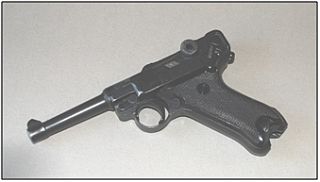
Luger P-08
Photo: Fred Nel
The most popular German handgun used was the Luger P-08. It was produced by DWM (Deutsche Waffen-und Munitionsfabriken) from 1900 and taken into service by the German Military in 1904, remaining in military use until the end of the Second World War in 1945. It was used in the campaigns in German South West Africa (GSWA) and German East Africa as well as throughout the European conflict zone. Although officially replaced by the Walther P38 in 1938, the Luger was used by German troops throughout the Second World War, including campaigns in North Africa and Europe, where South African troops took part. Many of these firearms were brought back to South Africa as souvenirs by returning troops from both World Wars.
As is usual in wartime, not only were the current models used, but any available weapons were used to make up numbers where there was a shortage. This included Mauser ‘Broomhandles’ (so called because of the shape of its butt) used by German colonial troops, including in the 1915 German South West Africa campaign. This was the first semi-auto pistol to achieve respectable sales figures. It was initially made by Waffenfabrik Loewe of Berlin. Loewe later merged with Deutsche Waffe und Mettalpatronfabrik to become the famous Deutsche Waffen und Munitionsfabrik or DWM. The pistol was later refined to become the famous Luger P-08.
It also has other interesting connections with southern Africa:
* It was carried by some Boer officers as well as some British officers in the Anglo-Boer War of 1899-1902 (British officers of the time were allowed to purchase and carry side arms of their choice) and is listed in Small Arms of the Anglo-Boer War 1899 – 1902 by Ron Bester.
* It is officially recorded that Winston Churchill carried one when he was a newspaper correspondent in South Africa.
* It was carried by some German officers in the in the 1914-15 conflict in German South West Africa. The Germans had been in South West Africa from the 19th century and would also still have had some of the original firearms used in various local uprisings.
The M1879 Reichsrevolver or Reichs-Commissions-Revolver-Modell 1879 and 1883 were German service revolvers from 1879 to 1908, when they were superseded by the Luger P-08. They were however still in use in the First World War.
In terms of rifles, in 1914 there was a general shortage both in Britain and in South Africa which resulted in units being equipped with whatever was available, including firearms dating from the Anglo-Boer War such as the .303Lee-Metfords and Long Lee-Enfields.
It is interesting to note that none of the Boer Mausers handed in after the end of the Anglo-Boer War were issued to the Union Defence Force in 1914, as it was possibly thought to be ‘politically incorrect’ (if anyone knew what that meant at that time) to use German rifles against Germans. That reason, however, does not gel with the Boer forces in the Anglo-Boer War who, through necessity, used as many British rifles and ammunition as they could lay their hands on.
For British rifles with double barrelled names (Martini-Henry, Lee-Metford and Lee-Enfield) the first name referred to the action and the second name to the barrel. The .303 Lee-Metford was the first bolt action rifle used by the British. In 1895 the Metford barrels were replaced using barrels with Enfield rifling, as the Metford barrels were stated by the British military authorities to be unsuited to the new cordite propellant. Subsequent opinion in some quarters claim however that the decision was political – William Metford was a private contractor not on good terms with the authorities, whereas Enfield was part of the establishment. There are, however, cases of Lee-Metfords being used in the 1914 rebellion and it remained in service up to the Second World War and after until it was replaced by the Lee-Enfield SMLE Mk lll which was in turn retained in service until replaced by the modified Rifle No 4. Subsequently all Lee-Enfield rifles were replaced by the 7.62mm Rifle.
The .303 Magazine Lee-Enfield Rifle, commonly known as the ‘Long Lee-Enfield’ because of its long barrel, was the second bolt action rifle adopted by the British Army, following the Lee Metford. They were used by the British military from the end of 1895 until the start of the20th century, including the latter stages of the Anglo-Boer War. It was replaced by the .303 SMLE (Short, Magazine, Lee-Enfield) Rifle, the ‘short’ referring to the reduced barrel length. The SMLE was introduced in 1902 and after minor modifications was finalised in 1907 as the Lee-Enfield Mk III. In 1926 all British rifles were re-named and the SMLE became Rifle No 1. It was used by British troops stationed in southern Africa in the early 20th Century, South African Colonial Units, and the Union Defence Force after 1910, as well as southern African forces in the First World War.
Two non-British rifles used during the First World War were the Pattern 1914 Enfield Rifle (P14) and the 6.5 X 58 Portuguese Mauser-Vergueiro Rifle. 20 000 of the latter were, at the request of the British, supplied to South Africa. They were also used by German colonial troops in East Africa, who captured them from the allied forces in combat, and preferred them to the actual Mauser rifles with which they had been issued. On the return to the Union, a number of the troops were permitted to demobilise with their rifles as gifts in recognition of their services. The Portuguese Mauser is therefore considered a uniquely South African military weapon. Apart from colonial conflicts, the invasion of GSWA and German East Africa by Union of South Africa forces were probably the only major armed conflict in which these rifles were ever used.
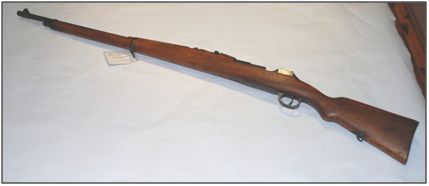
6.5 X 58 Portuguese Mauser-Vergueiro Rifle
Photo: Fred Nel
The following rifles were not intended for use by frontline troops, but released SMLEs for use at the front: The Canadian Ross Rifle, the Japanese Arisaka Rifle, the Bannerman ‘Mauser’ and the Winchester Model 1895.
The Mauser K98, commonly known as the 8mm Mauser, was adopted as the standard military rifle by the German Empire in 1905 and was used by German colonial troops in both World Wars. It would have been used in German South West Africa prior to the First World War, in wars between local tribes and the German Schutztruppe, such as in the Herero uprising in 1906. It would also have been used by the German troops in German South West Africa during the conflict with South African troops in 1915 and in the East African campaign in what is now Tanganyika, where large numbers of South African troops were also involved. The rifles were imported by Musgrave, with the intention of selling them to the Union Defence Force.This never happened and the rifles were sold on the commercial market instead.
Future meetings and field trips/ Toekomstige byeenkoms en uitstappe
The next meeting will be on Monday 11th January 2016 at 19h30 at the Eastern Cape Veteran Car Club in Conyngham Road, Port Elizabeth. The Curtain Raiser, Under wraps: the story of a top secret British military undertaking in 1915 (Part 1) will be by John Stevens. Ian Copley will present the main lecture titled President Machel plane crash revisited.
Matters of general interest / Sake van algemene belang
Individual members’ activities / Individuele lede se aktiwiteite
Andre Crozier has recently retired. SAMHSEC wishes him well and a fulfilling new life.
Barry Irwin has published a paper titled ‘Observed Correlations of Unsolicited IP Traffic across Five Distinct Network Telescopes’ in The Journal of Information Warfare. The Abstract is available at https://www.jinfowar.com/observed-correlations-unsolicited-ip-traffic-across-five-distinct-network-telescopes/.
Anyone wanting the full paper can contact Barry at b.irwin@ru.ac.za
Members’ forum/ Lede se forum
The following communication was received from Richard Tomlinson following the November field trip.
Two of the sites visited by SAMHSEC members are of special interest to me, so I was sorry to have missed this outing as I was away. These are:
1. The grave of Lt James Craig, VC, in South End Cemetery. In 2009, I researched and wrote an article for the Historical Society of Port Elizabeth (Looking Back Vol 48, pp 53-60) on this man, his life and his military service, because of his demise and burial in Port Elizabeth and the fact that I could find nothing written about him. This was followed by an update in Looking Back Vol 51, 2012, pp 23-27, following receipt of further information from a relative of James Craig living in Scotland; mostly family data.
2. Earlier still in 2006, again in pursuit of local information having seen the monument to Lt-Col John Fordyce in Pearson Street Congregational Church and SAMHSEC's visit to the Waterkloof, I did a similar operation on Fordyce which was published in Looking Back Vol 45, pp 8-19.
If any members would find these articles of interest, Richard is happy to scan and email them directly. His e-mail address is: richardtomlinson400@gmail.com
Poppy Day collection
A letter has been received from the Port Elizabeth Branch of The South African Legion, thanking SAMHSEC and expressing appreciation for its contribution to the 2015 collection. The proceeds of the Annual Poppy Day collection go towards assisting those less fortunate ex-servicemen and women who have fallen on hard times through no fault of their own, irrespective of race, culture, religion or ethnicity, as well as the poor Bushman communities in Pomfret and Plaatfontein – two communities in dire distress; they are all South Africans.
World War I Centenary Years / Eerste Wêreldoorlog Eeufeesjare
The British trenches on the Western Front(Part four on ‘Trenches’)
As noted in Newsletter 134, the Allied trenches were constructed with less intention of permanence in mind, but rather as launching places for attack, than was the case with German trenches which were seen as semi-permanent defensive structures. The Allied trenches were also generally on lower ground than the German trenches and consequently subject to flooding during rainy periods. There were broadly speaking three elements to British trenches: front line trenches, lined on the side facing the enemy by steps where defending soldiers would stand to shoot from, fire machine guns and throw grenades at any advancing enemy; communication trenches to the back lines; and ‘saps,’ – shallow positions that extended into no-man’s-land and were used mainly as observation posts.
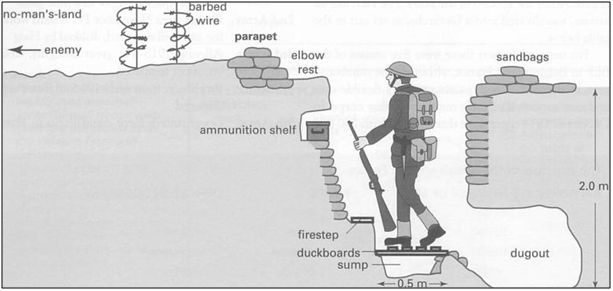
Idealised cross-section of a typical British front-line trench
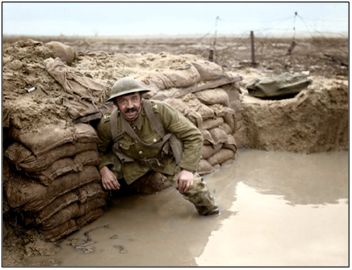
A colourized photograph of an advanced position at Loos. Unit and details unknown.
Source:
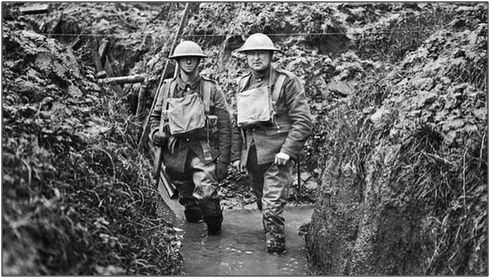
The Lancashire Fusiliers in a flooded communication trench, also showing lateral barbed-wire defence. St.Yves, near Ploegsteert Wood, January 1917.
Source:
Source:
http://www.warhistoryonline.com/war-articles/73317.html
A typical day in the trenches might have looked as follows:

Trenches of the 11th Cheshire Regiment at Ovillers-la-Boisselle, on the Somme, July 1916. One sentry keeps watch while the others sleep.
Source:
Source:
The trenches could be very muddy and smelly. There were frequently bodies buried nearby and the latrines sometimes overflowed into the trenches. Millions of rats infested the trenches and some grew as big as cats. There was also a big problem with lice whichtormented the soldiers on a daily basis. Trench foot from constantly wet feet, and pneumonia from the damp and wet were also constant problems.
In concluding this short series on ‘trenches’, which has focused on British and German trenches on the Western Front, one needs to bear in mind that there was also trench warfare on the French sectors as well as on the Austro-ItalianFront and at Gallipoli where similar circumstances and conditions prevailed, although not for the extended period of time that it did in Belgium and France.
For more comprehensive accounts of life in the trenches, see also:
and an interesting feature article at:
Major engagements in January 1916
Three relatively small battles took place in attempts to relieve the besieged British garrison at Kut-al-Amara (see Newsletter 135). These were the Battles of Sheikh Sa’ad on the 6th, the 8th and the 9th January, the Wadi on the 13th and Hanna on the 21st. All failed for one reason or another, including that the Turks outnumbered the British by five to one. Total British casualties for the three engagements were approximately 8 300. Turkish casualties are unknown, but were probably fewer.
Obituary:
Nikolay Belyaev the last survivor of the Soviet Army unit that stormed the German Reichstag in Berlin has died aged 93.
Fort Russ 8th December 2015 Translated from Russian by Tom Winter
https://www.warhistoryonline.com/war-articles/114877.html?utm_source=getresponse&utm_medium=email&utm_campai
gn=daily&utm_source=getresponse&utm_medium=email&utm_campaign=warhistoryonline&utm_content=[War+History+Online]+Your+Daily+Dose
World War I
The man who spared a wounded Hitler’s life in WWI – and changed the world forever
War History Online 8th December 2015
HMHS Britannic: The… other Titanic, sunk on 21stNovember 1916, in Greek waters
War History Online 5th December 2015
https://www.warhistoryonline.com/guest-bloggers/hmhs-britannic-the-other-titanic-sunk-on-21-november-1916-in-greece.html
John McCrae and ‘Flanders fields’
War History Online 2nd December 2015
Echoes from the past and links to Lenin: the past Swiss villagers tried to forget
Imogen Foulkes BBC News, Europe 29th November 2015
http://www.bbc.com/news/world-europe-34799462
World War II
HMS Ark Royal
War History Online 6th December 2015
Adolf Eichmann continued to support Nazism long after the war
Jennifer Hunter Constantine Report 2nd December 2015
http://www.constantinereport.com/adolf-eichmann-continued-support-nazism-long-war/
Foundation dedicated to WWII Monuments Men will close after Congressional Gold Medal ceremony
Christine Ayala The Dallas Morning news 20th October 2015
Cold War and post-Cold War
How the Soviets used IBM selectric keyloggers to spy on US diplomats
Dan Goodinars technica 13th October 2015
This is what BBC radio would broadcast in case of a nuclear war
War History Online 14th December 2015
Russia’s War Room
Tom Wyke Mail Online 23rd November 2015
Military History in the making
The mystery of ISIS’ Toyota army solved:
Tony Cartalucci NEO – Near Eastern Outlook 9th October 2015
http://journal-neo.org/2015/10/09/the-mystery-of-isis-toyota-army-solved/
Does the hybrid terrorism seen in Paris herald the dawn of a new phase of warfare?
Candyce Kelshall Defence iQ 23rd November 2015
Members are invited to send in to the scribes short reviews of, or comments on, books, DVDs or any other interesting resources they have come across, as well as news on individual member’s activities. In this Newsletter, there have been contributions by Richard Tomlinson, Malcolm Kinghorn, Barry Irwin, Michael Irwin and Peter Duffel-Canham.
Chairman: Malcolm Kinghorn: culturev@lantic.net
Secretary: Franco Cilliers: Cilliers.franco@gmail.com
Scribes (Newsletter): Anne and Pat Irwin: p.irwin@ru.ac.za
TAILPIECE:
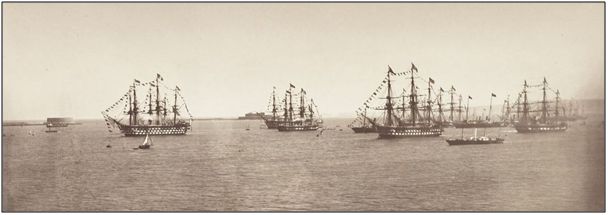
The Royal Navy on the way home from France with Queen Victoria, who had just visited Napoleon III, 1858.